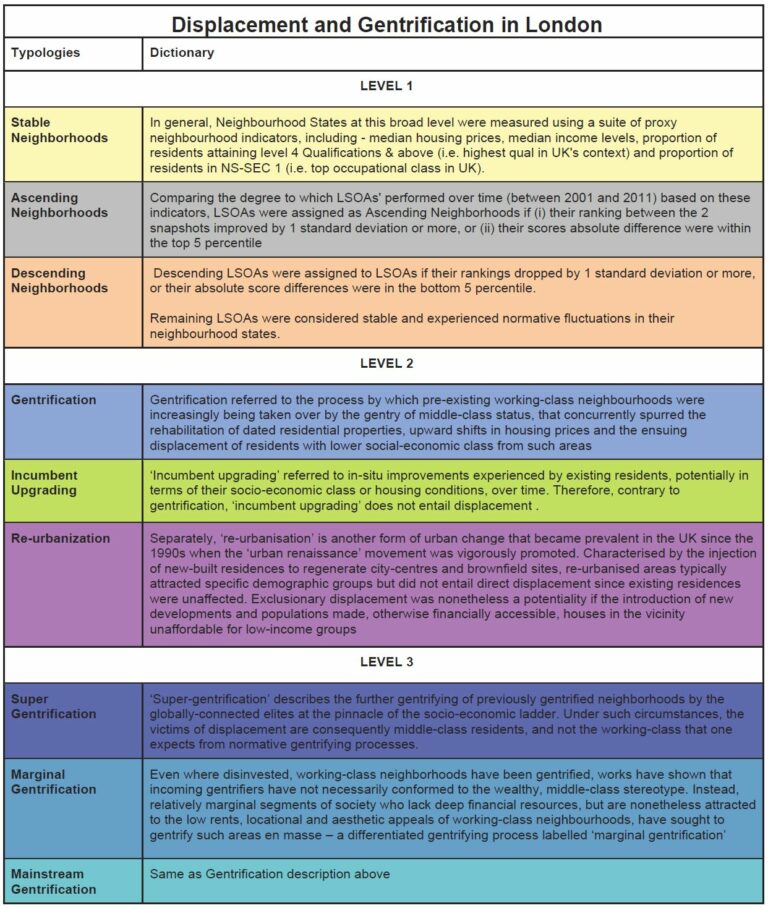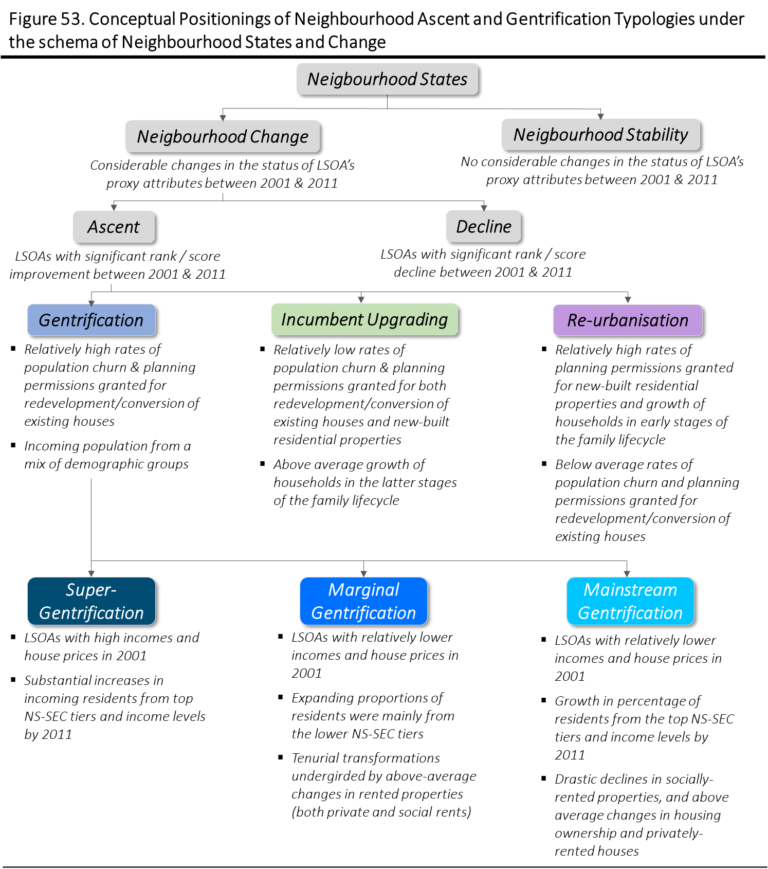Mapping Displacement and Gentrification in London, UK
Though more than 50 years have passed since the coinage of the term gentrification, gentrification in London has only accelerated in recent times, especially now that London is concurrently home to the majority of UK’s 1% richest and a large proportion of urban poor. Such trends have consequently spurred new manifestations of neighborhood change, in variegated forms, underscoring the need for robust policy-making to address the negative impacts posed by gentrification and displacement
To robustly tackle the nuances of London’s neighbourhood change, the CASA team, from the University College London, leveraged a suite of spatial analysis and Machine Learning techniques to analyse a multi-dimensional trove of high-resolution data. By contextualizing gentrification at the Lower Super Output Area (LSOA) unit in London, the team sought to identify and discern the different types of neighborhood changes as well as predict potentially at risk neighborhoods to aid in the policy-making process.
Key Findings
1. Between 2001 to 2011, 732 LSOAs were classified as ascending, 619 in decline and the remaining 3,484 LSOAs were considered stable.
Neighborhoods were assessed to be ascending, descending or stable depending on the relative degree of upward / downward changes in their neighbourhood conditions between 2001 and 2011. Ascending neighborhoods straddled across various boroughs in London, with higher concentrations found around Kensington & Chelsea, Westminster and Newham. On the other hand, descending neighbourhoods were notably situated towards London’s western peripheries including Ealing, Hounslow and Brent.
2. Gentrifying neighbourhoods are only but one form of ascending neighbourhoods, with other typologies comprising incumbent upgrading and re-urbanisation.
Gentrification, incumbent upgrading and re-urbanisation are varying types of ascending LSOAs. Although each typology is associated with some degree of uplift in terms of neighbourhood conditions over time, subtle differences distinguished them.
LSOAs categorised as gentrifying were observed to exhibit an influx of new households tending towards more mature demographics, much higher than average population churn rates and number of redevelopment permissions granted.
Conversely, LSOAs undergoing incumbent upgrading had much lower population turnover rates, and planning permissions granted for both new housing and redevelopment projects. Instead of being displaced, existing residents were experiencing in-situ uplifts in their socio-economic status while staying in-place over time. As these households progress through their lifecycle, a higher increase in percentage of households with children was observed.
Re-urbanised LSOAs, on the other hand, were characterised by significantly higher planning permissions given for new-built housing and an influx of residents of younger demographics. However, there was no evidence of high population turnover rates, which is indicative of the absence of direct displacement (found in gentrification’s case) since re-urbanisation did not typically affect areas with existing communities.
3. Mutations of gentrification in London are nuanced and varied, impacting differentiated segments of society and in particular spatial contexts.
LSOAs identified as gentrifying were further rationalised based on the nature and dynamics of changes observed in the socio-economic status of residents, house prices and income levels.
Of the gentrifying cluster, 162 LSOAs were classified as undergoing super-gentrification, whereby originally wealthy and expensive neighbourhoods were taken over by new residents possessing even higher socio-economic status and greater income levels.
Another 127 LSOAs were considered to be in marginal gentrification as neighbourhoods originally considered inexpensive and consisting of residents with lower than average incomes experienced an influx of new incomers from mid-low tiers of the socio-economic spectrum. These LSOAs also exhibited higher than average increases in the proportion of rental properties and a shrinking housing ownership base.
The remaining 45 LSOAs started out with more affordable housing and lower income levels. Over the years, people with higher status and wealth streamed in, causing huge rises in income levels and home ownership rates. In contrast, socially rented apartments were shrinking rapidly, indicative of the demolition of council housing to make way for gentrification to occur, in line with the nature of normative, mainstream gentrification.
4. Gentrification is predicted to grow and affect even more neighborhoods in London going forward.
Using an extensive array of data, geospatial analysis and AI techniques, the machine learning model developed as part of the study predicted an increase in gentrifying neighbourhoods within London. Specifically, previously isolated islands of LSOAs in super-gentrification near Chiswick, Clapham South and Dulwich are expected to expand markedly in future. As for marginal gentrification, LSOAs in this category are projected to grow more extensive around Brockley and Kensal Green. LSOAs in mainstream gentrification are predicted to retain a dominant foothold in London’s inner boroughs, though appearing more domineering across neighbourhoods north of the Thames.





